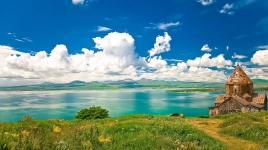Lake Sevan
Friday, October 15, 2021
Lake Sevan is the largest body of water in both Armenia and the Caucasus region.
It is one of the largest freshwater high-altitude (alpine) lakes in Eurasia. The lake is situated in Gegharkunik Province, at an altitude of 1,900.44 m (6,235 ft) above sea level. The total surface area of its basin is about 5,000 km2 (1,900 sq mi), which makes up 1⁄6 of Armenia's territory. The lake itself is 1,242 km2 (480 sq mi), and the volume is 32.8 km3 (7.9 cu mi). It is fed by 28 rivers and streams. Only 10% of the incoming water is drained by the Hrazdan River, while the remaining 90% evaporates.
The lake provides some 90% of the fish and 80% of the crayfish catch of Armenia. Sevan has significant economic, cultural, and recreational value. Its sole major island (now a peninsula) is home to a medieval monastery.
Sevan was heavily exploited for irrigation of the Ararat plain and hydroelectric power generation during the Soviet period. Consequently, its water level decreased by around 20 m (66 ft) and its volume reduced by more than 40%. Later two tunnels were built to divert water from highland rivers, which halted its decline and its level began rising. Before human intervention dramatically changed the lake's ecosystem, the lake was at an altitude of 1,916 m (6,286 ft) above sea level, 95 m (312 ft) deep, covered an area of 1,416 km2 (547 sq mi) (5% of Armenia's entire area), and had a volume of 58.5 km3 (14.0 cu mi).
Along with Lake Van and Lake Urmia, Sevan is considered one of the three great "seas" of historic Armenia.It is the only one within the boundaries of present-day Republic of Armenia, while the other two are located in Turkey and Iran, respectively. Lake Sevan is considered the "jewel" of Armenia and is "recognized as a national treasure" in the country. The 2001 Law on Lake Sevan defines the lake as "a strategic ecosystem valuable for its environmental, economical, social, scientific, cultural, aesthetic, medical, climatic, recreational, and spiritual value."
Chardin in 1673 noted the "extraordinary sweetness of the Water", the "small Island in the middle of it; where stands a Monastery built about 600 years ago, of which the Prior is an Archbishop", and "nine sorts of fish which are there taken; the fairest trouts and carps which are eaten at Erivan being caught in this Lake".
Naturalist and traveler Friedrich Parrot, best known for ascending Mount Ararat in 1829 for the first time in history, wrote that,
Sevan was recognized as being a major potential water resource in the 19th century. Its high attitude location relative to the fertile Ararat plain and limited energy resources attracted engineers to explore ways of usage of the lake's water. In his 1910 book, Armenian engineer Sukias Manasserian proposed using Sevan's water for irrigation and hydroelectric power generation. He proposed draining the lake by 50 m (160 ft). Major Sevan would completely dry out, while Minor Sevan would have a surface area of 240 km2 (93 sq mi).





